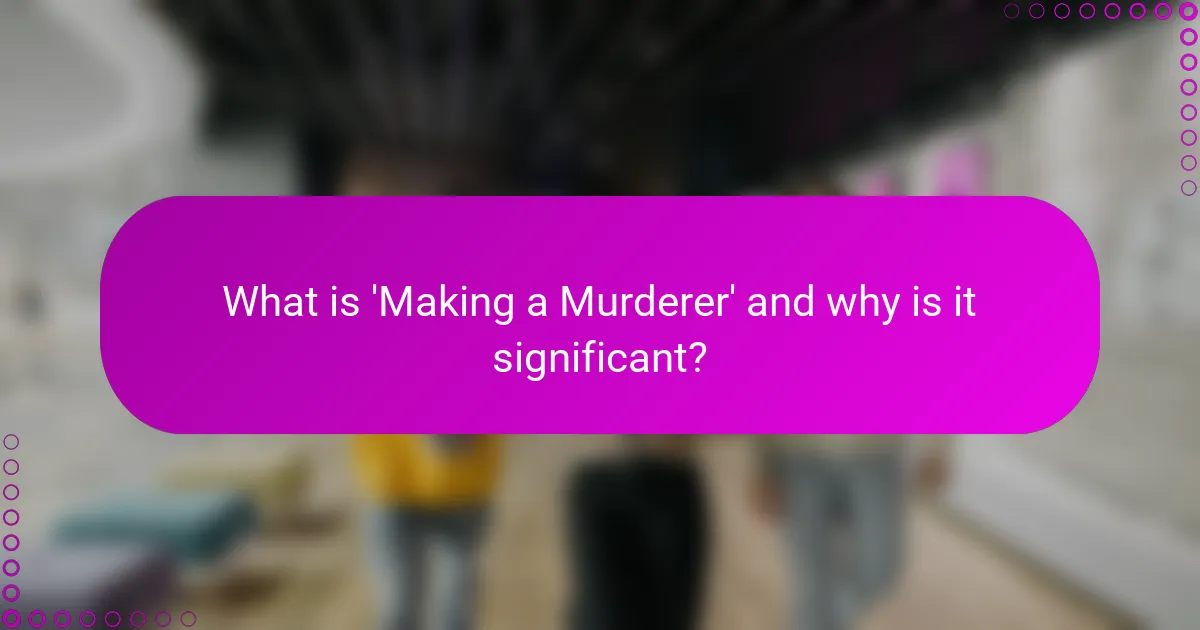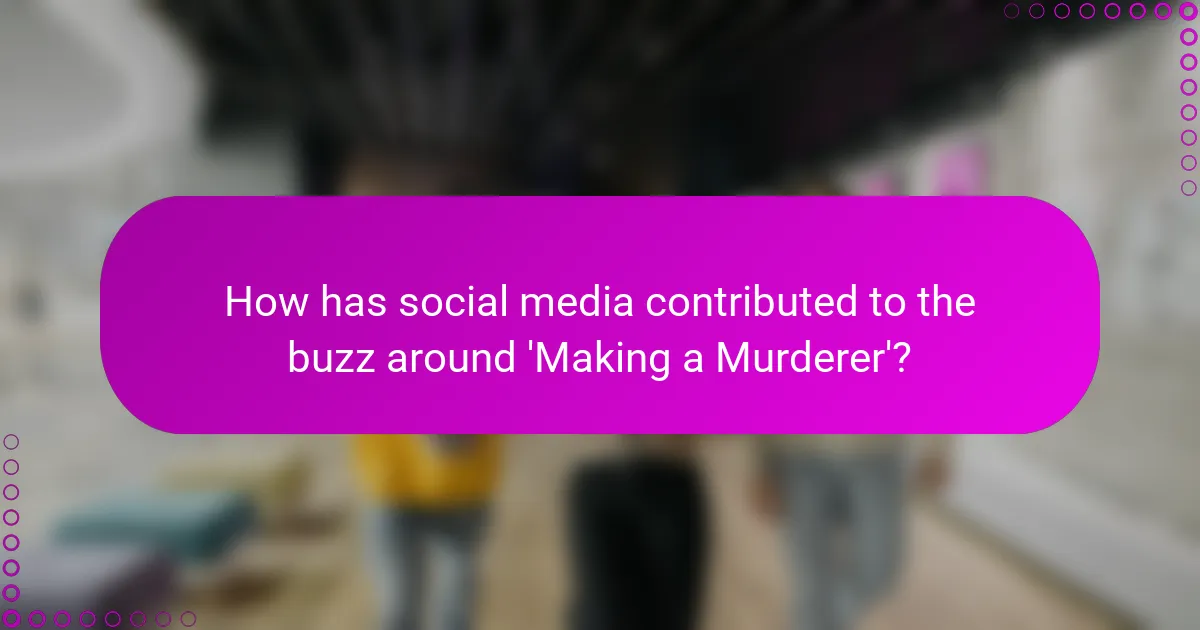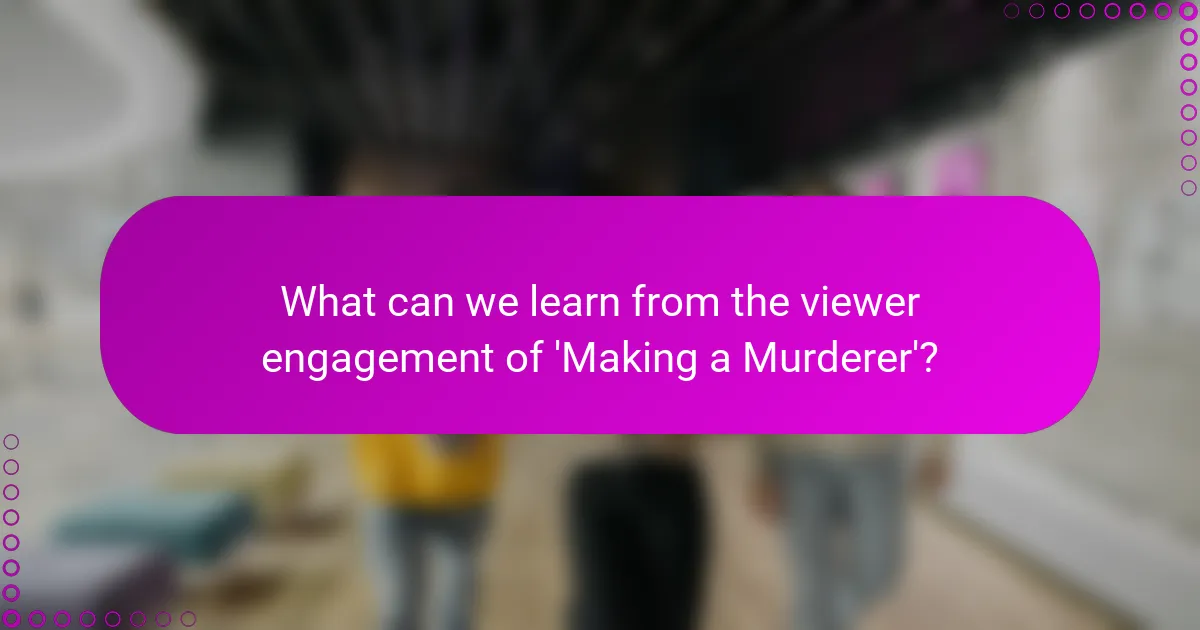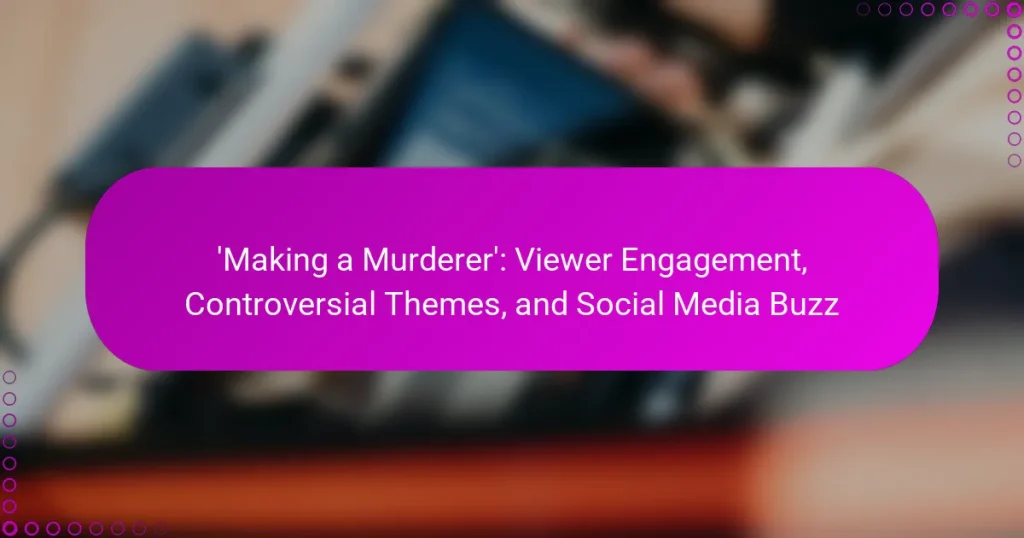‘Making a Murderer’ is a true crime documentary series that premiered on Netflix in 2015, focusing on the wrongful conviction of Steven Avery for assault and subsequent murder allegations. The series examines critical issues such as wrongful convictions, police misconduct, and systemic flaws within the criminal justice system, generating significant public discourse and raising awareness about these topics. It has also experienced substantial viewer engagement on social media, where platforms like Twitter and Facebook facilitated real-time discussions, trending hashtags, and user-generated content, amplifying its impact. The documentary’s controversial themes have led to intense debates and viewer activism, showcasing the influence of compelling storytelling on audience behavior and community dialogue.

What is ‘Making a Murderer’ and why is it significant?
‘Making a Murderer’ is a true crime documentary series that premiered on Netflix in 2015. It follows the story of Steven Avery, a man wrongfully convicted of [censured] assault and later accused of murder. The series highlights issues of wrongful convictions, police misconduct, and the flaws in the criminal justice system. Its significance lies in its impact on public awareness regarding these issues. The documentary sparked widespread debate and discussion about legal ethics and systemic failures. It also led to increased scrutiny of the cases presented and the institutions involved. The series garnered critical acclaim and a dedicated fanbase, influencing conversations on social media and beyond.
How does ‘Making a Murderer’ engage its viewers?
‘Making a Murderer’ engages its viewers through compelling storytelling and emotional investment. The series presents a real-life murder case, drawing viewers into the complexities of the legal system. It utilizes cliffhangers and dramatic pacing to maintain suspense throughout episodes. The portrayal of the main subjects, Steven Avery and Brendan Dassey, evokes empathy and connection. Viewers often feel compelled to discuss and debate the case, enhancing engagement. The series encourages critical thinking about justice and morality. Additionally, it sparked significant social media discussions, amplifying viewer interaction. The combination of these elements creates a powerful viewing experience that resonates with audiences.
What narrative techniques are used to captivate the audience?
Narrative techniques used to captivate the audience include suspense, character development, and emotional appeal. Suspense keeps viewers on edge, making them eager to see what happens next. Character development allows the audience to connect with individuals on a personal level. Emotional appeal evokes feelings that resonate with viewers, enhancing engagement. Additionally, cliffhangers create anticipation for future episodes. Flashbacks provide context and depth to the storyline. These techniques are effective in maintaining viewer interest and fostering discussions around the content.
How does emotional storytelling impact viewer engagement?
Emotional storytelling significantly enhances viewer engagement. It creates a connection between the audience and the narrative. This connection often leads to increased empathy and investment in the characters’ journeys. Research indicates that emotionally charged content can boost viewer retention rates. For instance, a study by the University of Pennsylvania found that emotional stories are shared 30% more than neutral ones. Additionally, emotional storytelling can prompt discussions on social media, further amplifying viewer engagement. This phenomenon is evident in series like ‘Making a Murderer,’ where emotional narratives drive audience interaction and debate.
What controversial themes are explored in ‘Making a Murderer’?
‘Making a Murderer’ explores themes of wrongful conviction, police misconduct, and the flaws in the criminal justice system. The documentary highlights the potential for bias in law enforcement. It raises questions about the reliability of evidence and witness testimony. The series also discusses the impact of media portrayal on public perception. Additionally, it examines the role of socioeconomic factors in legal outcomes. These themes provoke debate about ethics in criminal investigations. Critics argue that the series oversimplifies complex legal issues. Supporters contend it sheds light on systemic injustices.
How does the series address issues of justice and wrongful convictions?
The series addresses issues of justice and wrongful convictions by showcasing the case of Steven Avery. It highlights the failures within the criminal justice system. The series presents evidence that suggests mishandling of evidence and law enforcement bias. It raises questions about the integrity of the legal process. Interviews with key figures reveal systemic flaws in investigations. The series also emphasizes the emotional toll on those wrongfully convicted. Viewers are encouraged to critically analyze the judicial system. It serves as a platform for discussions on reform and accountability.
What ethical dilemmas are presented throughout the documentary?
The documentary “Making a Murderer” presents several ethical dilemmas. One significant dilemma is the fairness of the legal process. The documentary raises questions about the integrity of law enforcement and the judicial system. It highlights potential misconduct by police and prosecutors. This includes issues of coercion during interrogations. Another dilemma involves the presumption of innocence. The documentary challenges viewers to consider how media portrayal affects public perception of guilt. Additionally, the ethics of documentary filmmaking are scrutinized. The filmmakers’ role in shaping narratives can influence audience interpretation. These dilemmas provoke discussions about justice, accountability, and the impact of storytelling.
How has ‘Making a Murderer’ influenced public perception of the criminal justice system?
‘Making a Murderer’ has significantly influenced public perception of the criminal justice system by highlighting systemic flaws. The documentary series presents a detailed account of Steven Avery’s wrongful conviction. It showcases issues such as police misconduct and prosecutorial bias. Viewers have become more skeptical of law enforcement practices. The series sparked widespread discussions on social media platforms. Many people questioned the integrity of juries and legal procedures. Public interest in criminal justice reform has increased since its release. This shift in perception is evidenced by growing support for advocacy groups focused on wrongful convictions.
What reactions have emerged from legal professionals and activists?
Legal professionals and activists have expressed a range of reactions to “Making a Murderer.” Some legal experts have criticized the portrayal of the criminal justice system as biased. They argue that the documentary oversimplifies complex legal processes. Activists have highlighted the series’ impact on public perception regarding wrongful convictions. Many have called for reforms in the justice system based on the issues raised in the show. Some lawyers have noted increased public interest in cases of alleged miscarriages of justice. This series has sparked discussions about the ethics of documentary filmmaking in legal contexts. Overall, the reactions reflect a mix of concern and advocacy for systemic change.
How has the series sparked discussions about systemic flaws in law enforcement?
The series has sparked discussions about systemic flaws in law enforcement by highlighting investigative misconduct. It reveals how evidence was mishandled and critical leads were ignored. Viewers have noted the lack of accountability among law enforcement officials. The series showcases the impact of bias in the judicial process. Public reaction has been fueled by social media platforms, amplifying calls for reform. Numerous articles and discussions emerged, focusing on wrongful convictions and police practices. The case presented in the series serves as a catalyst for broader conversations about justice system integrity.

How has social media contributed to the buzz around ‘Making a Murderer’?
Social media has significantly amplified the buzz around ‘Making a Murderer’. Platforms like Twitter and Facebook enabled viewers to discuss episodes in real-time. This led to widespread sharing of opinions and theories. Hashtags related to the series trended during its release, increasing visibility. User-generated content, such as memes and fan theories, sparked further interest. Influencers and celebrities contributed to the conversation, reaching larger audiences. The series’ controversial themes fueled debates online, driving engagement. Online petitions for justice related to the case gained traction, showcasing collective viewer activism.
What role does social media play in shaping viewer opinions?
Social media significantly influences viewer opinions by facilitating discussions and sharing information. Platforms like Twitter and Facebook enable users to express their thoughts on shows like “Making a Murderer.” These interactions create a collective narrative around the content. Research indicates that social media discussions can shape viewers’ perceptions and interpretations. For instance, a study by the Pew Research Center found that 64% of social media users feel that these platforms help them understand various perspectives. Additionally, trending topics and hashtags can amplify certain viewpoints, impacting how viewers engage with the content. This dynamic underscores the powerful role social media plays in shaping public opinion.
How do social media platforms facilitate discussions about the series?
Social media platforms facilitate discussions about the series by providing spaces for viewers to share opinions. These platforms allow users to post comments, create threads, and engage in real-time conversations. Hashtags related to the series enable broader participation and visibility. Users can follow official accounts for updates and insights. Polls and surveys on these platforms gauge viewer reactions and preferences. Video clips and memes encourage creative expression related to the series. The ability to tag others fosters community interaction and dialogue. According to a study by Pew Research Center, 69% of adults use social media, making it a significant venue for discussions.
What impact do online communities have on the show’s narrative?
Online communities significantly influence the narrative of shows like “Making a Murderer.” They facilitate discussion and analysis of plot points and character motivations. This engagement can shape viewer perceptions and interpretations of the story. For instance, fan theories often emerge from these discussions, leading to alternative readings of the narrative.
Moreover, online communities can amplify certain themes or controversies within the show. This amplification can result in increased scrutiny from media and the public. The collective voice of these communities can pressure creators to address specific issues or questions raised by viewers.
In some cases, online reactions can even influence the direction of future episodes or seasons. An example includes how viewer feedback led to deeper explorations of particular characters’ backstories. This showcases the power of online communities in shaping ongoing narratives in real-time.
How have fan theories and discussions evolved on social media?
Fan theories and discussions have significantly evolved on social media. Initially, platforms like forums and blogs were the main venues for sharing theories. Social media has shifted this landscape, allowing for instant interaction and broader reach. Twitter and Reddit have become popular for real-time discussions and theory crafting. Hashtags and threads enable fans to organize their thoughts and share insights efficiently. The visual nature of platforms like Instagram and TikTok has also introduced multimedia elements to fan theories. This evolution has fostered a more dynamic and collaborative environment for fans. The rise of influencers and content creators further amplifies these discussions, giving them greater visibility. Overall, social media has transformed fan engagement into a more interactive and immediate experience.
What are some popular theories that emerged from viewer discussions?
Popular theories from viewer discussions of “Making a Murderer” include the idea of Steven Avery’s innocence. Many viewers believe he was wrongfully convicted due to mishandled evidence. Another theory suggests that law enforcement planted evidence to secure a conviction. Some viewers theorize that the prosecution was motivated by a desire to close the case quickly. Additionally, discussions often revolve around the potential involvement of other suspects in the crime. These theories gained traction through social media platforms and online forums. Viewer engagement led to widespread sharing of insights and debates regarding the case.
How do these theories reflect viewers’ engagement with the content?
Theories of viewer engagement reflect how audiences interact with content like ‘Making a Murderer.’ They highlight emotional responses, cognitive involvement, and social interaction. For example, the theory of parasocial interaction shows how viewers form attachments to characters. This attachment increases engagement and motivates discussions on social media. Additionally, the uses and gratifications theory explains why viewers seek out this content for information and entertainment. Research indicates that ‘Making a Murderer’ sparked significant online debate, showing its impact on viewer engagement. The combination of these theories illustrates a complex relationship between content and audience involvement.

What can we learn from the viewer engagement of ‘Making a Murderer’?
Viewer engagement with ‘Making a Murderer’ reveals significant insights into audience behavior and preferences. The series sparked intense discussions on social media platforms. It highlighted the power of streaming platforms in shaping viewer experiences. Engagement metrics showed high levels of binge-watching, indicating strong narrative hooks. The controversial themes resonated with viewers, prompting debates on justice and ethics. Audience reactions influenced public perception of the criminal justice system. The documentary’s format encouraged active participation, with viewers sharing opinions and theories. These factors illustrate how compelling storytelling can drive viewer engagement and foster community dialogue.
What strategies can content creators adopt from ‘Making a Murderer’?
Content creators can adopt several strategies from ‘Making a Murderer.’ They should focus on storytelling that emphasizes emotional engagement. This series effectively humanizes its subjects, creating a strong connection with viewers. Additionally, creators can explore controversial themes to provoke discussion and debate. ‘Making a Murderer’ drew attention by tackling complex legal issues. Leveraging social media for audience interaction is another key strategy. The series generated significant buzz through online discussions and fan engagement. Creators should also consider cliffhangers and suspenseful pacing to maintain viewer interest. This approach keeps audiences invested in the narrative. Finally, presenting multiple perspectives can enrich the storytelling experience, as seen in the series.
How can emotional storytelling enhance viewer connection?
Emotional storytelling enhances viewer connection by fostering empathy and relatability. It allows audiences to engage with characters on a personal level. When viewers see their own experiences reflected in a narrative, they form deeper emotional bonds. Research indicates that stories eliciting strong emotions can increase retention and engagement. For instance, a study published in the journal “Psychological Science” found that emotionally charged narratives are more memorable. This connection can lead to increased discussions and social media interactions. Engaging narratives can also provoke critical thinking about controversial themes. Overall, emotional storytelling serves as a powerful tool for creating lasting viewer engagement.
What lessons can be drawn about addressing controversial themes?
Addressing controversial themes requires careful consideration and sensitivity. Engaging audiences through dialogue can foster understanding. Balancing differing viewpoints is essential for constructive discussion. Transparency in presenting facts enhances credibility. Utilizing multiple platforms can broaden reach and impact. Audience feedback should be actively sought and incorporated. Historical examples show that mismanagement can lead to backlash. Successful navigation of controversy often results in increased viewer engagement.
How can social media be leveraged for future documentary series?
Social media can be leveraged for future documentary series by enhancing viewer engagement and broadening the audience reach. Platforms like Twitter and Instagram facilitate real-time discussions around episodes. They allow creators to share behind-the-scenes content, fostering a deeper connection with viewers. Social media can also be used to gather audience feedback and insights, which can inform future content. Engaging influencers to promote the series can amplify visibility. Additionally, targeted ads on social media platforms can attract specific demographics interested in the documentary’s themes. According to a 2021 study by the Pew Research Center, 69% of adults in the U.S. use social media, indicating a significant potential audience for documentary series.
What best practices can be implemented for audience interaction?
Best practices for audience interaction include actively engaging viewers through polls and questions. This encourages participation and feedback. Utilizing social media platforms for real-time discussions enhances connection. Responding to audience comments promptly fosters a sense of community. Creating shareable content increases visibility and invites further interaction. Hosting live Q&A sessions allows for direct communication with the audience. Analyzing engagement metrics helps refine strategies for better interaction. These practices are supported by studies showing that interactive content increases viewer retention and satisfaction.
How can creators encourage meaningful discussions online?
Creators can encourage meaningful discussions online by fostering a safe and inclusive environment. They should actively engage with their audience through open-ended questions. This invites diverse perspectives and encourages participation. Creators can also share thought-provoking content that challenges viewers’ assumptions. Research shows that content that stimulates critical thinking leads to deeper conversations. Additionally, responding to comments and acknowledging different viewpoints builds rapport. This interaction reinforces a community feel and motivates further dialogue. Furthermore, utilizing platforms that support threaded discussions can help maintain context. Overall, these strategies create a vibrant space for meaningful engagement.
‘Making a Murderer’ is a true crime documentary series that explores the wrongful conviction of Steven Avery and the complexities of the criminal justice system. The article delves into the viewer engagement generated by the series, examining narrative techniques, emotional storytelling, and the controversial themes of police misconduct and justice. It highlights the role of social media in shaping public perception and sparking discussions about systemic flaws in law enforcement. Additionally, the article outlines strategies for content creators to enhance audience interaction and foster meaningful dialogues online.


